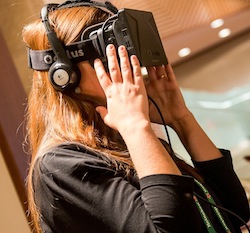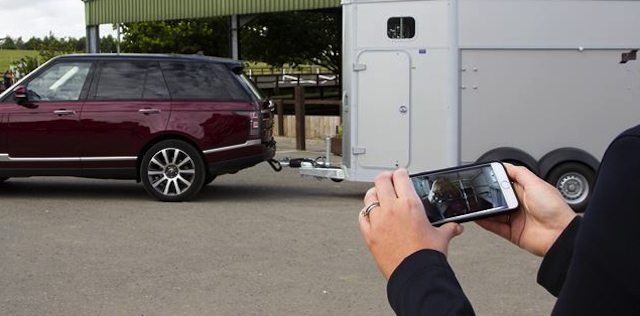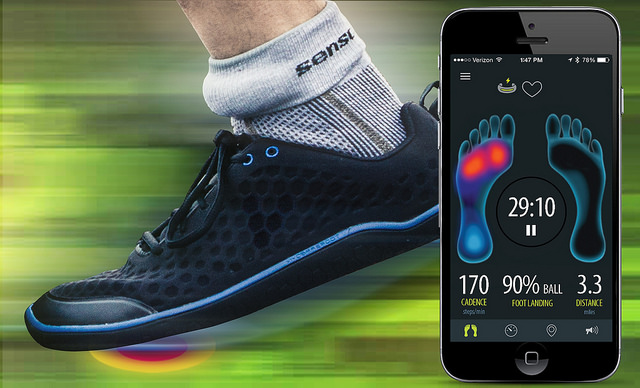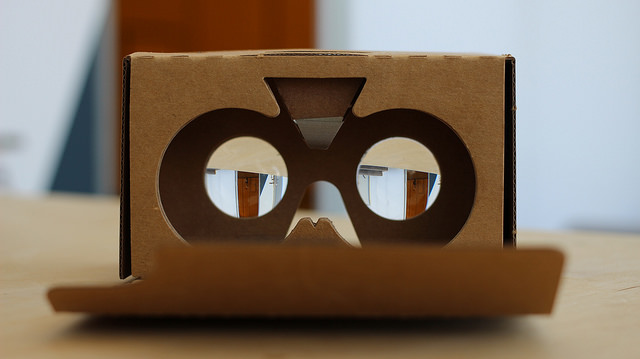High Tech for Horses and Wearable Sensors: CES 2016, Equestrian Style
- March 10, 2017
- ⎯ Fran Jurga

It was hard to find any hoofprints in the Sands Hotel at last week’s CES in Las Vegas. But if you had a good imagination, you would have seen plenty of possibilities for future technologies and products in the horse world–or for your truck, trailer, barn or office.
It is simply impossible to know everything that was displayed and promoted at this show. While some exhibits were for specific products, others were for the sensors themselves, the tiny engines that power the products. The sensor manufacturers showed products utilizing their products; at least one sensor manufacturer promoted a prototype of a horse product. Many others might have.

But this show isn’t about horses. It’s about drones and smart phones and high-definition televisions. Or maybe it’s about medical technology. Or fitness. It just depends where you’re standing.
CES had a 23 percent growth in sports and fitness exhibits this year, and the popularity of FitBit and similar “trackers” has meant that wearable sensors are here to stay. In a survey, 3000 sports professionals polled by the American College of Sports Medicine (ACSM) said that wearable sensor technology will be the top trend in fitness this year.Equestrians have two fitness goals in mind: their own and their horses’, so many riders are eager to know how they can make use of the technology that’s out there.
A quick video review of some of the sports-related products at CES.
CES is the place that made “keynote” a verb. As you would expect, Intel, Sony and Samsung took to the stage with elaborate events, but so did Ford and Volkswagen with keynotes of the automotive sort, and Netflix keynoted that it’s global now.
Tucked into the corners of the Sands Hotel’s vast exhibit area were villages of exhibits, each a massive trade show unto itself. And while the sports technology area was a fertile zone for horse visionaries, there were hints in other places as well. Here are a few examples of technology that might be coming to your barn, or your driveway, or your office soon.

By way of introduction, the idea of technology in the equestrian world is nothing new. It exists, but most of it is in the hands of professionals who work with horses being evaluated for medical or locomotor conditions or abilities. These applications require a lot of data, usually from multiple horses for comparison, and sophisticated software to drive the data in the right direction. “Home” or cosumer-level apps for horses left on their own or for riders to use during solo training sessions is another level. The new sensors have made many things possible we could only dream of a few years ago. But will equestrians embrace them? Or will their own uses of devices like FitBit help them see the value of monitoring their horses as well as themselves?
Let’s start with what may have been the only horse health product represented at CES 2016. The handsome leather NightWatch halter from Protequus was a hit at the American Association of Equine Practitioners (AAEP) Convention in December and it was back in Las Vegas for CES.
Here’s a video explaining how a halter can monitor your horse’s health, with Whitney Allen of the US Hunter Jumper Association and Ashley Craig, DVM of Hagyard Equine Medical Institute, among others:
Cameras are taking over the auto industry; the new i8 BMW demo car in Las Vegas has no mirrors at all. Even the side mirrors have been replaced with cameras. Land Rover may not have been exhibiting it there, but that company’s sensorized horse trailer technology, announced at Land Rover-sponsored Burghley Horse Trials in England last fall, uses research underway at the Royal Veterinary College in England. Apps include pressure sensitive floor mats, built in monitors, and some pretty amazing “see through” vision to get rid of towing blindspots.
And you can keep an eye on your horse in the trailer while you run into the show office or vet clinic.

How “sportified” is CES? It even hosts a sports business forum as part of the much larger event. The biggest trend there may have been marketing-driven; product after product was promoted as having a smart-design capability that would help prevent injury. In actuality, this usually translates to warning of fatigue, which is linked to many injuries. But it’s easy to see that the recent turmoil over the National Football League’s concussion-gate has filtered down to heightened concerns about children participating in sports, and injury prevention capabilities will certainly help sell a product in this climate.
To that end, there was a continued trend toward compression garments. Florida-based Motus has a new arm sleeve that is being marketed for “arm” sports like baseball, tennis and lacrosse. Here’s where the imagination kicks in: you can easily see that if that sleeve fit your leg instead of your arm, you would know what part of your leg was on the horse, and how much pressure was in which part of your leg. Some of the devices include real-time feedback on the data from leading athletes, so that as you reach endurance goals or as you work to attain a technique at a certain level, you’ll hear Olympic or pro athletes talking you through motions or giving you kudos.
Smart socks seem like a good idea. Sensoria lets the user make the most of a sock by mining it for data. Using these updated socks, you can compare data between different pairs of running shoes (or even boots, perhaps). It even senses the pressure on the bottom of the foot. The promo promises to tell you not just how far and how fast you run, but how well you run.
Who’ll be the first to slip one of these onto a horse hoof? Maybe someone already has!

Sensoria doesn’t stop at their socks. They introduced a “whole field of play” system at CES that works by outfitting a team of players in their “sensorized” compression shirts and footwear. The system will monitor heart rate, accelerations, decelerations, passes and shots, and also track the movements of the player on the field. Can you tell where this train of thought is going? The data collected is translated into:
- A heat map of the field showing player movements on the field
- A heat map of a player’s shoes showing the distribution of shots and passes
- Data charts and gauges related to biometric data collected during the game
- Charts showing team-related stats, determined by correlating individual players telemetry
It may be no surprise that Sensoria partnered with Microsoft on this project; both companies are located in Redmond, Washington. The data collected by Sensoria boots and clothing sensors is interpreted by the Microsoft Soccer Dashboard.
Now what if those shirts and boots were on polo players? Or any type of riders at all?
In the specifically equestrian department at CES, EverySense’s SmartRider was entered in the startup competition. SmartRider came to Las Vegas from Japan, where an interesting group of biomechanists worked on the product line. A combination of Japanese and European equestrian competitors consulted on the project.
SmartRider’s PowerPoint said that it collected data from the rider’s hands, legs and body as well as all four legs, plus cardiac data, from the horse, using 11 sensors. It automatically detects the horse’s pace. They plan to go on to surfing and snowboarding next.
That’s it for the startups and the incubators extrapolated to horses on the consumer side. What were the big guns doing and who were the big guns, in product arenas that might be applied (sooner or later) to horses?

Intel seems to be on top of the game, at least in terms of publicity. The chip giant is launching a tv show called “America’s Greatest Makers” to showcase entrepreneurs working in the tech app and wearable sensor app fields. Intel’s “Curie” sensor is being made available to developers in what sounds like an enticing offer.
As you watch the next video, imagine that the free runner is a dressage horse. Or a reining horse. At the Intel keynote, attendees in person and watching the stream around the world saw Curie’s precise mocap calculations of free runner Jason Paul’s hang time, rotation, body angle, landing force, spin and much more. Paul and other athletes can one day use this data to better understand their spins, jumps, vaults and flips in order to naturally conquer obstacles and do tricks never before thought possible.
You might find the Curie sensor in any number of the products described in this article, but you’re probably wondering what energy drink maker Red Bull was doing at an electronics show. Red Bull’s image is inseparable from energy and movement, and the brand has created a media mass that reflects it. During CES, Intel and Red Bull announced a collaboration to make Red Bull’s high energy extreme sports videos available for licensing through Shutterstock. The spinning freestyle skiiers and BMX aerialists in the videos will be wearing Curie sensors, and the data will read out on the screen, just as it does on Jason’s free running sample.
Red Bull just needs to meet the right horses. Do you think they’ve seen mounted archery?
Here’s your invitation to create some great equestrian tech, courtesy of Intel, for the new television show.
And then there are the sports brands we all know. Or think we know.
Under Armour had a dynamic presence at CES as it announced a new division: Meet UA HealthBox. Under Armour believes that you will pay for devices that will tell you how you feel. First, though, they might tell each other. This major expansion of the athleticware company is a bit of a headscratcher for the horse world, since Under Armour founder Kevin Plank is the owner of Sagamore Racing, a successful operation that has even boasted a Breeders Cup winner. So far, there’s no news of a HealthBox for Horses, but the ears are up.
HealthBox’s first products include a wristband, a weight scale, a heart rate strap, and the free apps that tie it all together and display it on your smart phone.
But it’s the Gemini 2 sensor shoe that had everyone talking. Put it this way: you can wear a sensor app on your wrist or on your feet. This is low maintenance tech. The apps just work away, and you view the data when you feel like it. This means less stumbling during a run because you’re looking at your phone!
Great brands think alike. New Balance, based here in Boston, is an established footwear manufacturer that is branching out to sensorized shoes. Their new division is called New Balance Digital Sport; expect to see more than shoes from them. They make a custom sole printed for your foot on a 3-D printer. Intel and Google are among New Balance’s partners.
In the media department, the hot technique is 360 degree video. You can build a system, as promoted in the Intel stage area, but who wouldn’t like to try Nikon’s newKeyMission 360 camera? It’s a Go Pro on a permanent pirouette. You have to wear VR glasses to watch the videos, of course…

And finally, under the inevitable heading of “Yes, there’s an even app for that…” were several examples of the ultimate wearables: app-equipped sports bras. They looked less than comfortable, however, with a plastic box attached to the elastic band, but perhaps you won’t feel it. The OMbra received the most attention.
CES has come and gone for another year, but there are a dozen or more other events where horse-tech may be easier to find. The South by Southwest® (SXSW®) Conference in Austin, Texas merges an interactive/tech/web conference with a film festival and a music event; the 30th SXSW kicks off March 11. You will probably find more on the content and interactivity side there than you would have found at CES, which is, after all, pretty much about technology as a means to an end. Go to CES to find out about what powers all the apps; go to SXSW to find out what you can do with them.
Sometimes at these events, you have to open your eyes wide to see how something relates to horses. Other times, you have to squint. (Still others, you have to look through VR goggles!) If you can find tech people with the time to talk (they are there to sell, after all), you’ll find that they probably don’t know much about horse care or competition. Most don’t even seem to be aware that people treat and think of their horses as athletes.
You’ll also find that developers can be challenged when asked to accommodate different riding disciplines or radical differences in the sizes of horses. Dogowners, on the other hand, already have plenty of products to choose from, including Voyce, which is shown in this simple video. It’s been on the market for a year, comes in four sizes, and won the equivalent of “best in show” for its category at CES 2014.
The response usually heard about horse devices is that all we need is to track how fast Thoroughbreds run. Period. Developers have a lot to learn about the equestrian world, just as we have a lot to learn about how to use tech in training and competition.
There are dozens of veterinary sensor products in develop or even in actual use, and they may ultimately help bring the horse owner into the picture. Zoetis recently equipped 900 dog owners with Voyce monitors to collect data on canine arthritis. That’s a great example of getting the tech out into the field and starting a buzz.
They can’t adapt their products for equestrianism if they don’t know how the sports work. We can’t reap the benefits of their technology unless they are truly interested in what we’re doing. Go talk to them. Bring them to an event. Put a new-generation FitBit on your wrist and a pair of tried-and-true waterproof barn boots on their feet, open the gate, and see what happens next.
Learn more:
Health Buzz: The American College of Sports Medicine Predicts the Top Fitness Trends of 2016
Note: CES was formerly known as the Consumer Electronics Show but has now changed its name to simply “CES”.





